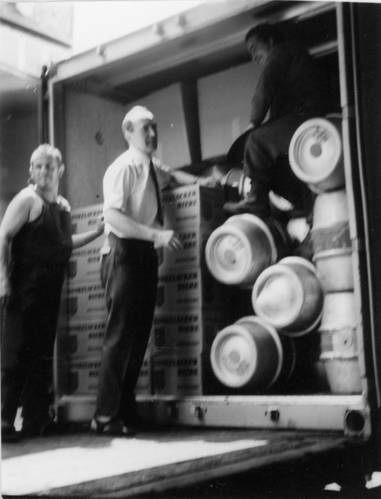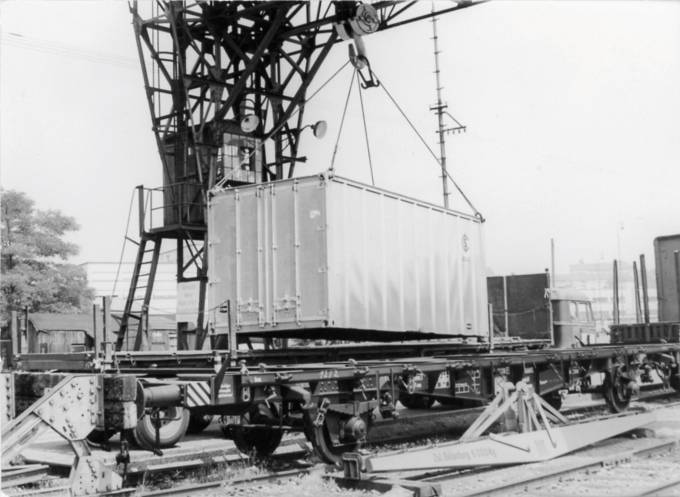In 1966 North German Lloyd (NDL) carried out Germany’s first multimodal door-to-door shipment. The customer was delighted as cargo could no longer ‘get lost’ on the way. An interesting, almost forgotten story from the beginning of the container era.
The announcement by the American shipping company Sealand at the beginning of 1966 that they would establish a container service between the East Coast of the U.S.A. and Europe caused action at Hapag and NDL. A few short weeks later a member of the Hapag executive board, the head of the freight departments in Hamburg and Bremen, a representative from ‘container’ operator Contras, two brokers and one staff member from each of our German freight agencies met in an former brewery on the River Elbe in Hamburg to assess Sealand’s plans. A professor from the University of Berlin facilitated the meeting of experts that searched for an answer to the central question: Does the container have potential for ocean transportation and how should one react to the American newcomer’s offensive?
The first container-like transport boxes made of steel with a volume of five, seven and ten cubic meters were already in operation, but this was about a 20-foot container with an inside volume of over 31 cubic meters. “It was the first meeting about containers between the shipping lines, Hapag and NDL. Most of the gentlemen present had never even seen a 20-foot container,” remembers our former Hapag-Lloyd colleague Peter Koehler, who was there as the representative from the Stuttgart freight agency for North German Lloyd.
“In the Port we were shown a 20-foot container. Afterwards each had to give their verdict, would the newfangled box ever attract cargo? At that time I only thought: Which of our customers has enough cargo for America to fill a 20- or 40-foot container?" The experts for and against were in equal numbers, but despite this, it was decided a short time later that both shipping companies would hire a few containers in America, and put them into service to and from the U.S. East Coast. “Of course then no one even thought what a success story the container would turn out to be – not even the colleagues who gave the aluminum box a chance in the market at that meeting,” he said. “The container on show in the Port at that time did not have doors but a kind of roller-shutter that had to be pulled up."
After the meeting all freight agencies and brokers were telephoned and asked to acquire cargo for the test containers. As a selling argument they should convince the customers that they could largely forego the need to pack in smaller boxes and from door-to-door no one needed to touch the cargo, reducing the risk of damage or theft and also insurance rates. “The Dinkelacker brewery in Stuttgart was my customer. They exported beer in bottles and kegs to New York and had to calculate in considerable losses on the long journey. The port workers in Bremen and New York were thirsty. The beer bottles in their cartons were easily recognizable. I saw my chance,” recounts Koehler. The sales discussion went surprisingly well, but ended not surprisingly with the brewery boss insisting that the transportation could not cost be more than before and had to begin on the brewery premises, from door-to-door.
“Our problem was that up to that time the beer had been delivered by truck to Bremen by Dinkelacker. Now, without high extra costs we had to get the empty container to the brewery in the Stuttgart city-center, where there was no rail siding,” said Peter Koehler, who until his retirement in 2002 worked in the Hapag-Lloyd office in Munich. Very soon it was clear that we had to get the empty 20-foot container to the nearest goods station, then load it onto a truck to be taken to the point of loading. Then the container with the beer would return to the rail siding by truck, be taken by train to the ship in Bremen and from there to New York, then by truck to the Brooklyn customer who traded in German foodstuffs. “That must have been the first multimodal shipment even though this term did not exist at the time,” believes Peter Koehler.
But multi-transport was easier said than done. No containers had been handled at the goods station in Stuttgart before. “There was a 30-ton crane available, but without a suitable crosspiece to move the containers correctly,” he said. “We did not know if a one-and-a-half ton container carrying over 16 tons of beer would bend in the middle, if it was just lifted by the four corners using a wire cable, without a crosspiece. The railways also had to find a suitable truck: There were no standards then like there are today.”
June 16, 1966 was the day of reckoning. The 20-foot container was packed to the limits with the kegs of beer and advertising materials. Would the rail wagon be able to handle the weight? “The crane had to lift the box only 25 centimeters up from the truck, our nerves were on edge, the tension was as tight as were the wire cables on the four corners of the container.” It was loaded onto the wagon, equipped with special holding rods, without problems and reached Bremen undamaged on June 18 and travelled as deck cargo to New York.
“No cargo loss, less paperwork, lower insurance costs and so lower total cost – The Director of Dinkelacker was very pleased and from that time on all traffic from the brewery to New York was by container,” Koehler said. “Three months later the goods station in Stuttgart had a special crane crosspiece to lift the new containers.”
















